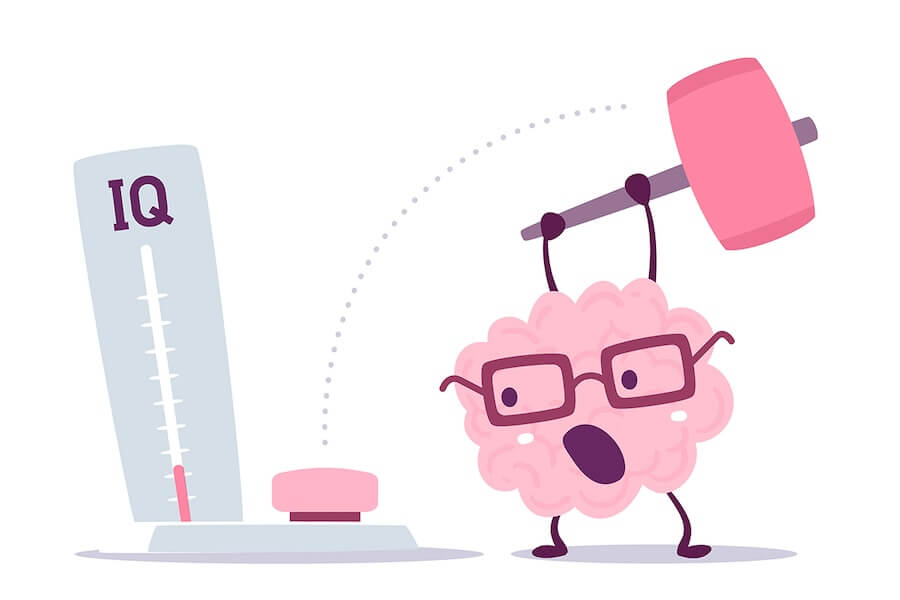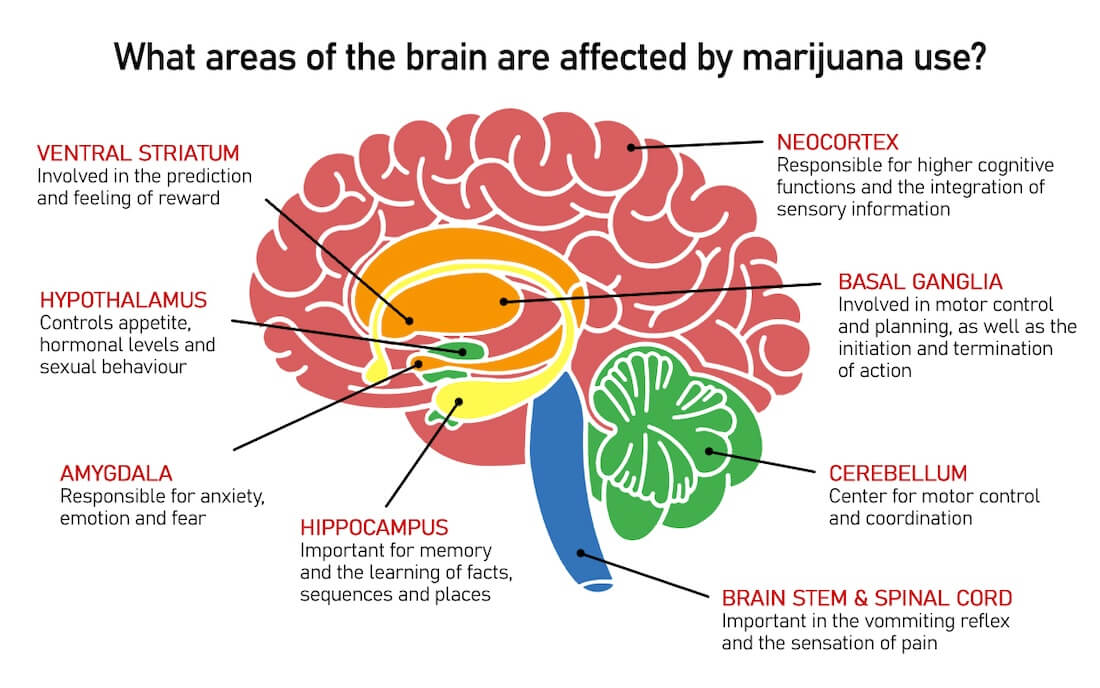We are all familiar with the classic stoner image – unproductive, slow, unmotivated, distracted, but at some point, many of us asked ourselves, does weed actually make us dumb?
The short answer is …maybe, but we don’t really know. Research shows conflicting results, and there is anecdotal evidence for both.
In a nutshell, weed affects some aspects of our cognition, like memory and attention, but it doesn’t strictly relate to how smart we are. Science tells us that people might be particularly vulnerable if they start using in adolescence before their brains are fully grown. Cannabis might interfere with essential brain processes that can influence our development and lead to cognitive problems later on.
It’s not clear, however, if this is true after marijuana leaves our bodies. It’s also uncertain how long we have to smoke weed before there are any notable adverse effects.
To unravel this mystery, let’s explore intelligence, how cannabis interacts with our body and brain, and what science says about it. We’ll also discuss the challenges involved in answering this question.
What Do We Consider as “Dumb?”
To be defined as “dumb,” we mean a notable decrease in intelligence or IQ, measured by standardised tests. Since we will review scientific research, we need some form of criteria that we can rely on.
Generally, we understand intelligence as the ability to reason, solve problems, and learn new things. This process is connected to our cognitive functions.
Cognitive functioning refers to the brain’s capacity to process information, including perception, attention, and memory.
IQ—or intelligence quotient—is the standard most widely used to assess general intelligence.

How Does Cannabis Affect Our Body?
OK. Now that you know what we mean by dumb let’s see how cannabis affects our bodies.
Cannabis has over 100 active compounds called cannabinoids. Here, we’ll concentrate on only one of them since it’s the hero (or the villain) of our story.
THC, or delta-9 tetrahydrocannabinol (Δ9-THC), is the primary psychoactive cannabinoid. It’s the one that makes us high. It does its job by attaching to specific receptors and interacting with neurons responsible for thinking, memory, pleasure, coordination and movement.
These receptors, called CB1 and CB2 receptors (CB – cannabinoid), are sprinkled throughout our bodies and are part of the Endocannabinoid System (ECS). This ancient mechanism resides in the central and peripheral nervous systems, and it helps our organism maintain balance and adjust to outside conditions. It regulates vital functions like appetite and digestion, sleep, pain sensation, mood, metabolism, learning and memory, reproduction, inflammation, and other immune responses. So, it’s super important.
To stimulate the CB receptors, our bodies produce endocannabinoids similar to the ones in the cannabis plant. This means that we all have tiny cannabis-like molecules floating around in our organism. THC essentially works its magic by hijacking the endocannabinoids’ function.
The Endocannabinoid System and the Brain
CB1 receptors exist in very high densities in our brain, specifically the cerebral cortex, hippocampus, and cerebellum.
The cerebral cortex, also called grey matter, is our brain’s outermost layer of nerve cell tissue. It plays a vital role in memory, thinking, learning, reasoning, problem-solving, emotions, consciousness and functions related to our senses.
The hippocampus, found in the inner region of our temporal lobe, is part of the limbic system and is primarily associated with storing and processing long-term memory.
The cerebellum, which is Latin for little brain, coordinates muscle movements and balance. It also plays a role in cognitive functions like language and attention.
The way the CB1 receptors are positioned in these regions is connected to how cannabis, THC in particular, alters their function.
The consensus is that it impacts our attention and memory. Since they are crucial for learning, reasoning, planning, and decision-making, researchers believe cannabis also affects IQ. Proving this, however, seems to be quite challenging.

What Does Science Say About Weed and Intelligence?
Right. We’ve reached the meat of our story.
As we explained, ingesting or smoking THC messes with our ability to process new information into memory. It also makes it harder to access those memories. Notably, the cannabinoid tends to make us more prone to mistakes by mixing up facts. The impact depends on how much we take, how regularly, and how long it’s been since it entered our body. However, studies are still unclear about how long these effects last after we’ve stopped using cannabis.
Researchers are also uncertain about marijuana’s effects on our cognitive abilities. The best way to determine its impact is through a so-called longitudinal study, in which scientists track the development of a large group of people over long periods of time. They split the participants into two groups – users and non-users – and then try to determine the cognitive changes between them. This is where things get murky.
We can summarise the results by reviewing two conflicting studies, which differ in how they gather data.
One uses participants from different genetic and social backgrounds and the other tracks twins who naturally have almost identical sociobiological makeup.
First Study
The first study from Duke University, published in The Proceedings of the National Academy of Sciences (PNAS) in 2012, follows 1,037 individuals from New Zealand from birth (1972/1973) to age 38. The researchers periodically interviewed them at the ages of 18, 21, 26, 32, and 38. They also performed neuropsychological testing at age 13, before cannabis use, and again at age 38.
The study concludes that using marijuana leads to overall cognitive declines and an average decrease of around 6 IQ points. The most significant effects were observed in consistent users—those who reported using marijuana in at least three interviews between the ages of 18 and 38. Interestingly, the cognitive deficits were not evident in individuals who started using marijuana as adults but were pronounced in those who began using it during their teenage years. Additionally, the researchers gathered information from participants’ close friends and family members through questionnaires. They’ve asked them about their daily routine, revealing that weed lovers tend to fare worse than abstainers.
However, a subsequent review of this study, published in 2013 in the same journal, challenges the findings by examining its research methods and criteria. It states that the New Zealand study doesn’t address several supporting factors that could also affect cognitive development. These are substance abuse, like alcohol and tobacco, a history of mental illness, their family relationship or socioeconomic development.
The author concludes, “Although it would be too strong to say that the results have been discredited, the methodology is flawed and the causal inference drawn from the results premature.”
Second Study
The second study we want to address paints a much different picture. Published in 2016 also in PNAS, it follows an alternative approach by examining the development of 3,000 identical American twins. The authors’ goal was to eliminate as many supporting factors as possible, which influenced the results of the previous study.
Same as the first one, researchers divided the twins into users and non-users and examined their IQ between the ages of 9 and 12 before marijuana use and then again between 17 and 20 after use. And again, same as before, the results showed that marijuana users had worse test scores and lower IQ than before.
What it also discovered, however, is that there was no correlation between IQ and weed and that both groups of twins showed a reduction in intelligence.
The authors conclude, “Short-term cannabis use in adolescence does not appear to cause IQ decline or impair executive functions, even when cannabis use reaches the level of dependence. Family background factors explain why adolescent cannabis users perform worse on IQ and executive function tests.”

So, what does that mean?
When looking into it, investigators first found out that young people who use marijuana are also much more likely to abuse alcohol, cigarettes and drugs. This raises the question of whether the decline in IQ is possibly connected to overall substance use.
Furthermore, traits like impulsivity and a tendency for risky behaviour predicted both substance use and lower IQ. The same goes if parents neglect their children or if there’s a history of trauma. It’s kind of obvious that kids who engage in delinquent behaviour, like skipping school, drinking alcohol, and using drugs, end up with lower grades. So, it turns out that cannabis use itself isn’t the cause of cognitive decline. Instead, a mix of inherited and environmental factors seemed responsible for both.
In other words, smoking weed might be a sign of just being dumb rather than the cause of it.
Also, if cannabis hurts our IQ, we’d think that the more we smoke, the less intelligent we become. However, the study discovered that heavier use doesn’t necessarily lead to a more significant decrease in IQ.
This doesn’t mean that recreational use is harmless. There are adverse mental health and physical effects caused by it, especially in prolonged heavy use.
We are waiting for data from the most robust study so far, which is supposed to answer all our prayers.
Adolescent Brain and Cognitive Development Study
The recently launched Adolescent Brain and Cognitive Development (ABCD) study, funded by the US National Institutes of Health (NIH), follows 11,000 U.S. 10-year-olds in a national sample. It captures normal brain development and IQ before any substance use with serial testing and brain imaging. The study then documents any longitudinal consequences of such use.
Scientists hope that this will finally settle the issue between cannabis and cognitive decline. Meaningful results should appear in the next few years as the kids enter their mid-teens.
Adolescent vs Adult Cannabis Use and Its Effects on the Brain
These examples, however, focus on the cognitive development of young minds and don’t explain if there’s a connection between smoking weed as a kid and as an adult. It is also essential to address the burning question of whether weed negatively affects our brains in the long run, specifically after we’ve stopped smoking.

There are valid reasons why the teenage brain might be particularly sensitive to marijuana. The natural cannabinoids we produce are vital in brain cell development and migration, starting from the fetal stage. At the same time, the hippocampus, which is essential for creating new memories, is littered with cannabinoid receptors. Since THC affects the receptors, it might disrupt these essential natural processes.
Some studies also suggest that starting cannabis from a very early age increases the chances of heavy dependence later on. Childhood is a crucial and sensitive time for children’s development, and marijuana use can affect brain structure and function. This can cause difficulties in learning and adapting, leading to long-term consequences in adulthood.
Signs are also pointing to a connection between cognitive decline and the amount of cannabis consumed. Heavy use might cause a lasting impact on neurocognitive performance. One study found that high THC dose, specifically in joints, affects people’s performance in tasks that require thinking and movement. People who smoke a lot of weed can also exhibit cognitive issues similar to those seen in schizophrenia. Some studies show improvements after a month of abstinence, but others say the problems persist, especially in attention, memory, and decision-making.
Science is much more lenient when it comes to cannabis use as an adult when the brain is fully developed.
Turning back to the New Zealand study, the researchers determined that after 18 — even with heavy use — people didn’t show a significant decline in cognitive functions or IQ.
Although marijuana’s effects on memory and attention remain, they seem to be short-lived, and people tend to return to baseline after the THC has left their system. Currently, there isn’t enough consistent evidence for lasting effects after a period of abstinence.
Overall, the most consistent issue for regular users is trouble remembering words.
We still need more research to say for sure whether using marijuana leads to lasting drops in IQ. There are also things that scientists need to account for, like the emergence of new cannabis products and the increasing THC amount in existing ones.
Challenges when Conducting Cannabis Research
We briefly touched on some of the difficulties connected to cannabis research. Now, let’s see what they are in more detail. We discuss how things are in the U.S. since most research is done there.
There are four main issues when we talk about cannabis science and research in general:
- State regulations
- Issues with the legal cannabis supply
- Limited funding and resources
- The research itself – methods of gathering data and participants’ individual differences

Regulation
The most obvious obstacle is cannabis’ Schedule I status under the Controlled Substances Act. Because of this, investigators have to jump through many bureaucratic and administrative hoops to conduct their study. They need to pass a series of review processes that may involve the National Institute on Drug Abuse (NIDA), the U.S. Food and Drug Administration (FDA), the U.S. Drug Enforcement Administration (DEA), institutional review boards, offices or departments in state government, state boards of medical examiners, the researcher’s home institution, and potential funders. In general, the more people are involved, the more rules scientists have to comply with. Often, these rules affect the end result.
Legal Supply
A problem also exists with how you obtain cannabis since, currently, the only legal institution providing it for scientific purposes is the National Institute of Drug Abuse (NIDA). And NIDA only operates with one licensed laboratory in Mississippi. The reason is that any substance used for research must meet FDA’s human study standards. This is connected to another lengthy registration process with its own set of licenses and approvals.
As a result, there are variety and potency issues, and products don’t mimic what people get on the street or from dispensaries. At the same time, there are increasingly more options available on the market, like dabs, THC drinks, tinctures, etc., which are not yet tested in controlled conditions and are not available for research.
The situation presents a conundrum where the types of cannabis products available to the public continue to increase. Yet, research is limited to only a handful of cannabinoids, modes of delivery, and doses.
Funding
Another significant limitation of cannabis research is, of course, access to money. Until recently, there were very few funding opportunities dedicated to studying the effects of cannabinoids. Because cannabis has historically been thought to have only negative effects, the majority of research has been conducted under the National Institutes of Drug Abuse (NIDA). NIDA is part of the National Institute of Health (HIH), the primary support source. In 2019, its budget for research projects was USD 9.6 billion, but only around 2% was dedicated to cannabinoids. In addition, only around 19% of the projects got approved for funding. This creates a very competitive environment with many particular rules.
The proposals are evaluated on their potential impact, innovation, and likelihood of success. This requires existing infrastructure, institutional support, relevant experience, and a Schedule I license. These might be tough to acquire, especially when we talk about decades-long projects.
The good news is that the situation is improving. Since cannabis legalisation is moving forward globally, more and more stakeholders are getting involved. Many universities have their own programs. States where weed is legal also provide funding for research. International collaboration also plays a significant factor.
Conducting the Research
The last obstacle that scientists need to overcome is how they gather data and interpret results. This is tightly connected to the project’s scope and time frame. When it comes to studying peoples’ brains and cognitive abilities, it gets harder to monitor changes over long periods of time. As people go through life, their circumstances change, and their experience affects the results.
Furthermore, investigators must account for individual variations and uniformity of weed habits. All participants have to use the same strain and amount over the same time period. Another problem is that most studies rely on self-reporting. As we all know, people tend to hide their problems or embarrassing facts about their lives, which are often important to those studying them.
Initially, 90% of cannabis research was done using test animals, like rats. They are genetically similar to us and are much easier to examine. Lab rats, however, are not humans. And their life doesn’t account for the complexities of human society, which significantly affect our choices and the people we become.
Individual Differences
This is connected to our differences as individuals- how we live, what we eat, our genetic predispositions, our physical and mental state, how we are raised, what jobs we have, etc.
Also, when it comes to cannabis, there’s a psychological gap between folks who use it and those who don’t. Comparing users to non-users in a single moment isn’t very helpful since researchers are not sure what caused the cognitive effects.
It is simply too complex for scientists to account for every variable affecting the results.

Conclusion
Ultimately, our intelligence is influenced by many factors that begin in the womb. Because of the complexities of our biology and society, it’s tough to come up with an accurate and definite answer about marijuana’s effects.
Does weed make us dumb…? It’s possible.
What science tells us is that it’s definitely not good if we start smoking from a young age, before our brain is fully developed.
What we do know is that marijuana isn’t harmless. There are risks and benefits associated with its use. But exaggerating the extent of those risks and benefits won’t help us make smarter decisions about it. For proof of this, simply review the history of the drug war.
“If long-term cognitive effects are shown to be real, this conclusion should result in appropriate plans to regulate use through educational efforts and tough legal sanctions. On the other hand, if cognitive effects are transient or better explained by sociological phenomena, we can all take a step back and direct our efforts and resources elsewhere”, says former FDA commissioner, Scott Gottlieb.








Leave a Comment